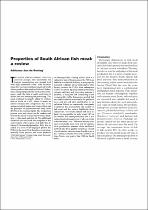JavaScript is disabled for your browser. Some features of this site may not work without it.
- ResearchSpace
- →
- Research Publications/Outputs
- →
- Journal Articles
- →
- View Item
| dc.contributor.author |
De Koning, AJ

|
|
| dc.date.accessioned | 2007-06-08T06:31:34Z | |
| dc.date.available | 2007-06-08T06:31:34Z | |
| dc.date.issued | 2005-01 | |
| dc.identifier.citation | De Koning, AJ. 2005. Properties of South African fish meal: A review. South African Journal of Science, vol. 101, 2 January, pp 21-25 | en |
| dc.identifier.issn | 0038-2353 | |
| dc.identifier.uri | http://hdl.handle.net/10204/448 | |
| dc.description | Copyright: 2005 Acad Science South Africa | en |
| dc.description.abstract | The South African fishing industry converts pelagic fish unsuitable for human consumption into animal feed with high nutritional value. Nine factories along the west and southeast coasts of South Africa produce fish meal and fish oil. Fishermen, acting independently from factory managers, catch the fish at night and bring it ashore the next morning for processing. The meal produced is largely added to chicken feed at levels of 3–10%, where it forms an almost irreplaceable component due to its unique essential amino acid composition and the presence of polyunsaturated fatty acids (PUFA) in the residual lipids. The production process uses only steam (in the cooker) and heat (in the dryer) to make the two final products — fish meal and fish oil. No additional chemicals are used with the exception of the antioxidant ethoxyquin (1,2-dihydro-6-ethoxy-2,2,4-trimethylquinoline, EQ), that is added at a level of 400 mg/kg to protect the PUFA in the meal. It is therefore an environmentally clean process and waste products are biodegradable. Drying of fish meal is a vulnerable part of the process as the PUFA are liable to be oxidized if drying is not properly managed. Addition of EQ immediately after drying protects the PUFA from subsequent aerobic oxidation. Spoilage of fish in the delay between catching and processing remains a problem, as icing the fish aboard ship is not economically viable. Processing spoiled fish inevitably leads to a reduction in the quality of meal and oil and also contributes to air pollution. Efforts are continually being made to improve the manufacture and quality of fish meal and this review highlights these endeavours. | en |
| dc.language.iso | en | en |
| dc.publisher | Acad Science South Africa | en |
| dc.subject | PUFA | en |
| dc.subject | Polyunsaturated fatty acids | en |
| dc.subject | Pelagic fish | en |
| dc.subject | Fish meal | en |
| dc.subject | Fish oils | en |
| dc.subject | South African fishing industry | en |
| dc.subject | Poultry feed | en |
| dc.subject | Animal feed | en |
| dc.title | Properties of South African fish meal: A review | en |
| dc.type | Article | en |
| dc.identifier.apacitation | De Koning, A. (2005). Properties of South African fish meal: A review. http://hdl.handle.net/10204/448 | en_ZA |
| dc.identifier.chicagocitation | De Koning, AJ "Properties of South African fish meal: A review." (2005) http://hdl.handle.net/10204/448 | en_ZA |
| dc.identifier.vancouvercitation | De Koning A. Properties of South African fish meal: A review. 2005; http://hdl.handle.net/10204/448. | en_ZA |
| dc.identifier.ris | TY - Article AU - De Koning, AJ AB - The South African fishing industry converts pelagic fish unsuitable for human consumption into animal feed with high nutritional value. Nine factories along the west and southeast coasts of South Africa produce fish meal and fish oil. Fishermen, acting independently from factory managers, catch the fish at night and bring it ashore the next morning for processing. The meal produced is largely added to chicken feed at levels of 3–10%, where it forms an almost irreplaceable component due to its unique essential amino acid composition and the presence of polyunsaturated fatty acids (PUFA) in the residual lipids. The production process uses only steam (in the cooker) and heat (in the dryer) to make the two final products — fish meal and fish oil. No additional chemicals are used with the exception of the antioxidant ethoxyquin (1,2-dihydro-6-ethoxy-2,2,4-trimethylquinoline, EQ), that is added at a level of 400 mg/kg to protect the PUFA in the meal. It is therefore an environmentally clean process and waste products are biodegradable. Drying of fish meal is a vulnerable part of the process as the PUFA are liable to be oxidized if drying is not properly managed. Addition of EQ immediately after drying protects the PUFA from subsequent aerobic oxidation. Spoilage of fish in the delay between catching and processing remains a problem, as icing the fish aboard ship is not economically viable. Processing spoiled fish inevitably leads to a reduction in the quality of meal and oil and also contributes to air pollution. Efforts are continually being made to improve the manufacture and quality of fish meal and this review highlights these endeavours. DA - 2005-01 DB - ResearchSpace DP - CSIR KW - PUFA KW - Polyunsaturated fatty acids KW - Pelagic fish KW - Fish meal KW - Fish oils KW - South African fishing industry KW - Poultry feed KW - Animal feed LK - https://researchspace.csir.co.za PY - 2005 SM - 0038-2353 T1 - Properties of South African fish meal: A review TI - Properties of South African fish meal: A review UR - http://hdl.handle.net/10204/448 ER - | en_ZA |






